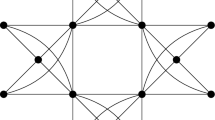Abstract
We show that the independence polytope of every regular matroid has an extended formulation of size quadratic in the size of its ground set. This generalizes a similar statement for (co-)graphic matroids, which is a simple consequence of Martin’s extended formulation for the spanning-tree polytope. In our construction, we make use of Seymour’s decomposition theorem for regular matroids. As a consequence, the extended formulations can be computed in polynomial time.
Similar content being viewed by others
Change history
16 December 2019
We report a logical error in our article that turns out to be fatal for the main result. The error lies in Lemma 3 for the case of a 3-sum, that is
16 December 2019
We report a logical error in our article that turns out to be fatal for the main result. The error lies in Lemma 3 for the case of a 3-sum, that is
References
Conforti, M., Kaibel, V., Walter, M., Weltge, S.: Subgraph polytopes and independence polytopes of count matroids. Oper. Res. Lett. 43(5), 457–460 (2015)
Edmonds, J.: Submodular functions, matroids, and certain polyhedra. In: Guy, R., Hanani, H., Sauer, N., Schoenheim, J ( eds.) Proceedings of the Calgary International Conference on Combinatorial Structures and Their Applications, pp. 69–87. Gordon and Breach, New York (1970)
Fiorini, S., Kaibel, V., Pashkovich, K., Theis, D.O.: Combinatorial bounds on nonnegative rank and extended formulations. Discrete Math. 313(1), 67–83 (2013). http://arxiv.org/abs/1111.0444
Fiorini, S., Massar, S., Pokutta, S., Tiwary, H.R., de Wolf, R.: Linear vs. semidefinite extended formulations: exponential separation and strong lower bounds. In: Proceedings of the Forty-fourth Annual ACM Symposium on Theory of Computing, STOC ’12, pp. 95–106. ACM, New York, USA (2012). doi:10.1145/2213977.2213988
Grande, F., Sanyal, R.: Theta rank, levelness, and matroid minors. arXiv:1408.1262 (2014)
Iwata, S., Kamiyama, N., Katoh, N., Kijima, S., Okamoto, Y.: Extended formulations for sparsity matroids. Mathematical Programming (2015). doi:10.1007/s10107-015-0936-8 (printed version to appear)
Kaibel, V., Weltge, S.: A short proof that the extension complexity of the correlation polytope grows exponentially. Discrete Comput. Geome. 53(2), 396–401 (2015). doi:10.1007/s00454-014-9655-9
Lawler, E.L.: Combinatorial Optimization: Networks and Matroids. Courier Corporation, New York (1976)
Martin, R.K.: Using separation algorithms to generate mixed integer model reformulations. Oper. Res. Lett. 10(3), 119–128 (1991). doi:10.1016/0167-6377(91)90028-N
Oxley, J.G.: Matroid Theory, vol. 1997. Oxford University Press, Oxford (1992)
Rothvoss, T.: Some 0/1 polytopes need exponential size extended formulations. Math. Program. Ser. A 1–14 (2012). doi:10.1007/s10107-012-0574-3
Rothvoss, T.: The matching polytope has exponential extension complexity. In: Proceedings of the 46th Annual ACM Symposium on Theory of Computing, STOC ’14, pp. 263–272. ACM, New York, NY, USA (2014). doi:10.1145/2591796.2591834
Schrijver, A.: Theory of Linear and Integer Programming. Wiley, New York (1986)
Schrijver, A.: Combinatorial Optimization—Polyhedra and Efficiency. Springer, Berlin (2003)
Seymour, P.D.: Decomposition of regular matroids. J. Comb. Theory Ser. B 28(3), 305–359 (1980)
Tutte, W.T.: An algorithm for determining whether a given binary matroid is graphic. Proc. Am. Math. Soc. 11(6), 905–917 (1960). http://www.jstor.org/stable/2034435
Williams, J.C.: A linear-size zero—one programming model for the minimum spanning tree problem in planar graphs. Networks 39(1), 53–60 (2002). doi:10.1002/net.10010
Acknowledgments
We would like to thank Klaus Truemper for valuable comments on the decomposition of matroids.
Author information
Authors and Affiliations
Corresponding author
Additional information
V. Kaibel and S. Weltge acknowledge support by Deutsche Forschungsgemeinschaft (KA 1616/4-1). J. Lee was partially supported by NSF grant CMMI–1160915 and ONR grant N00014-14-1-0315.
Rights and permissions
About this article
Cite this article
Kaibel, V., Lee, J., Walter, M. et al. Extended Formulations for Independence Polytopes of Regular Matroids. Graphs and Combinatorics 32, 1931–1944 (2016). https://doi.org/10.1007/s00373-016-1709-8
Received:
Revised:
Published:
Issue Date:
DOI: https://doi.org/10.1007/s00373-016-1709-8




